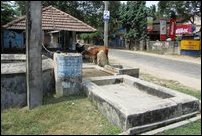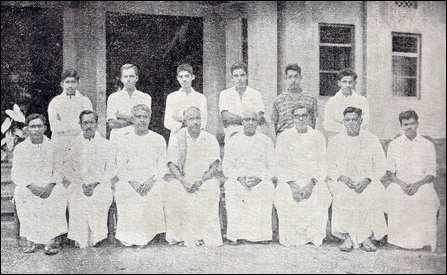Ilankai Tamil Sangam29th Year on the Web Association of Tamils of Sri Lanka in the USA |
|||
 Home Home Archives Archives |
100 years of Thirunelveali YMHAAnthropology of a grassroot institutionTamilNet Feature, March 7, 2011
Thirunelveali was a major centre of tradition-bound Saivism in Jaffna. In the Portuguese times, a chief of this village denounced his office and went to Chithamparam, after protesting the rule that every village should supply cows to the Portuguese for meat. He became an ascetic in Chithamparam and was called Gnaanappirakaasa Munivar. He wrote a commentary to the Saiva Siddhantha text Sivagnaana Chiththiyaar in Tamil. He was also the author of some books in Sanskrit. While at Chithamparam, a person who recovered his lost treasure through the divining powers of Gnaanappirakaasar came forward to give half of that treasure and insisted that the ascetic should accept it at least for the sake of using it for doing charity. With that money, Gnaanappirakaasar built a tank and a Mutt at Chithamparam. Both exist to this day in his name. The 17th century mutt is an interesting wooden architecture of three courtyards. The tank and the surroundings became the centre for the settlements and mutts of the people of Jaffna in Chithamparam. As people of Thirunelveali had some connections with Kaaraitheevu (Kaarainakar), a family from that island is now maintaining the Gnaanappirakaasar mutt. The government hospital of Chithamparam functioning today in the land of Gnaanappirakaasar, is a living testimony to the continuity of his charity. Most of the mutts built by the villages of Jaffna in Chithamparam, the Kokkuvil mutt, Changkaanai mutt, ka’l’liyangkaadu mutt, Vara’ni mutt, Maathakal Maanaa Muthaliyaar mutt, the house of the great Tamil scholar and teacher, Madduvil Vetpillai Upaaththiyaayar and a temple for Cheakkizhaar where a shrine for Gnaanappirakaasar could be found, are in the same locality. The mutts, which are three-courtyard-buildings, are in highly dilapidated conditions. One of them retains only the foundation and some walls. Eezham Tamil pilgrims who go to Chithamparam should visit this site to see an earlier legacy of their diaspora. Another Eezham Tamil of the Portuguese times, Thillai Naayakath Thampiraan of Vara’ni in Jaffna also went to Chithamparam due to Portuguese oppression and became a disciple of Thirunelveali Gnanappirakaasar. He founded the Saiva Siddhantha Mutt, Vara’ni Aatheenam. He was endowed with the rights of the temple at Thiruma’raikkaadu (Vedaranyam) for curing the ailment of the Maratha king at Thanjavur. The majestic temple at Vedaranyam and some other temples coming under it are even now administered by the Vara’ni mutt of Jaffna. Arumuga Navalar was a descendent of the family of Thirunelveali Gnaanappirakaasar. No wonder, Thirunelveali was one of the early centres in Jaffna that conceived an institution such as the YMHA, even though the nomenclature smacks of the influence of the churches. From the old records we come to know that the Thirunelveali YMHA was inspired by the thoughts of Swami Vivekananda. Leaders like Sir Ponnampalam Ramanathan, Youth Congress social revolutionary like Handi Perinpanayagam, Tamil scholars like Pa’ndithama’ni Kanapathippillai, literary personalities like Suddhananda Bharathy and artistic preceptors like Vazhuvoor Ramaiyapillai were speakers or performers in its functions. Students of Jaffna Hindu College and St. John’s College from the village were the main participants of the institution in the initial years. Besides lectures, debates, story-telling and recitations, sports facilities were provided at Pa’nikkar Va’lavu, adjacent to the present cricket grounds of the Jaffna University. The College of Theatrics Naadaka Arangakak Kalloori that was functioning in the YMHA building in the late 1970s made an island-wide impact in Eezham Tamil theatre. Initially meeting at the Muththuth-thambi Viththiyaasaalai school, the association moved to its present venue near the junction in 1918. From making bricks to building the structure the members did it by their own hands. The ‘Junction Institutions’ have a fascinating history in Jaffna. Roughly a century ago, every major junction in the peninsula had a resting place called Madam for the pedestrians and caravans on the highway as well as people of the locality to take rest. A Madam was always a complex having five components: an open hall on a raised platform usually under a shady tree, a well, a water-tub for the cattle to drink water, a half pillar-like cylindrical stone called Aavurangnchik-kal for the bullocks of the caravan to massage their bodies and relax and another structure called Chumai-thaangki, which is a platform built to the height of a person for pedestrians with head load to keep it and take it back without assistance. Building such complexes was considered a great charity in those days. A Chumai-thaangki was particularly built to the memory of a woman died in childbirth. Such Madams were also socio-cultural centres where people met, talked, played games and even had a nap in the hot afternoons. With the advent of the ‘steam-petrol civilization’ the caravans and load-carrying pedestrians disappeared and along with that the Madams became irrelevant. It was by that time, a new movement came up replacing the institution of Madams, and that was building reading rooms called Vaasika-saalai. Most of the reading rooms were either built on the very site where the Madams existed or adjacent to the Madams if they were still in use. The reading rooms with newspapers and magazines made a silent revolution in social equality in a caste-ridden society, in grassroot literacy, general knowledge of the youth and in socio-political awareness. In the early 1970s when Mrs. Bandaranayake’s government restricted the arrival of Tamil magazines from India under the pretext of ‘foreign exchange’, and when every reading room couldn’t get the magazines, the writer remembers bicycling to a far away reading room that was getting the magazines where one had to compete even for a seat to sit down. The reading rooms were also sports clubs, social service organisations and relaxing centres for the youth. Everybody knows that the ‘Junction Institutions’ were also centres for little pranks of the youth. The youth may organize Tha’n’neer Panthal with great fervour for the local temple festival. But on another evening, a section of them may also go to the temple to get the Chu’ndal Prasaadam to take it as a bite with the season’s palmyra toddy. But the ‘Junction Institutions’ helped the youth to grow with ‘understanding’ supervision of the elders. The institutions facilitated the youth a feeling and belongingness to the land they lived. In short, they were pivotal institutions of grassroot civil society. The Thirunelveali YMHA belongs to that genre. It was built just 25 yards away from the old Madam complex at the junction. Right from having a permanent building in 1918, it was functioning as one of the pioneer and major reading centre in the region. In the 1970s on any evening one could easily count a hundred youth in and around the building. Those who were considered loafing around there are doing very well in life inside and outside of the island today. But then came a time of state military oppression and militant retaliation of the society that eroded away many of the civil society institutions. The old timers ‘graduated’ from the Thirunelveli YMHA met in London Sunday to prepare for the centennial celebrations. It shouldn’t be merely nostalgia. The big question is what is the next stage of evolution of the Junction Institutions in the Age of Information. For more than two decades now, the junctions have become check posts of an occupying military and they are becoming more and more a permanent institution. The Age of Information in whatever truncated form in Jaffna is confined to little screens at home. The youth have no time to read anything but to attend to tuition classes and they don’t any more have secure late evenings. The nation of Eezham Tamils needs creative thinking in making their civil institutions meaningful to the age. There could be several ways and means, from transfer of traditional knowledge to introduction of innovative and alternative courses, for the control of damages caused by corporate-minded education that is going to be on the escalation soon. But as a priority, the Young Men Hindu Association and similar institutions should make a bold step in doing away with the ‘men’ part. It is high time that we should make our institutions gender equal for a healthy society.
| ||

